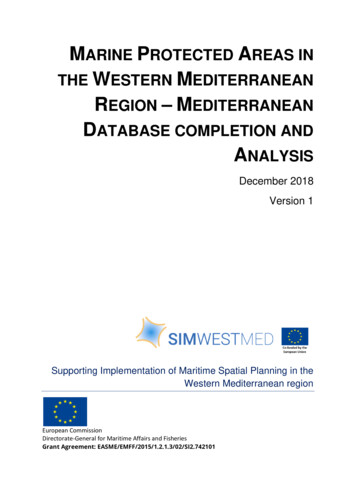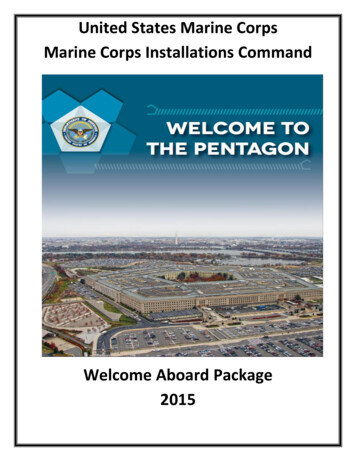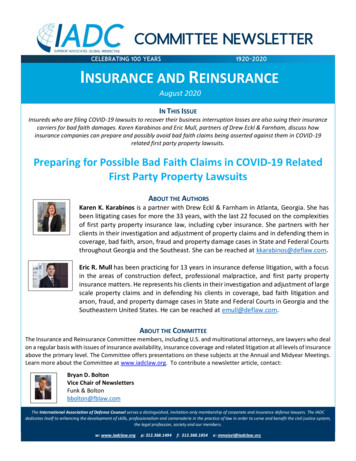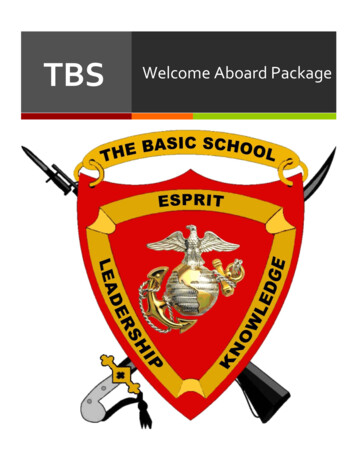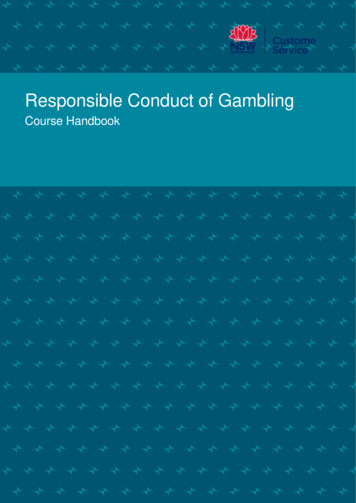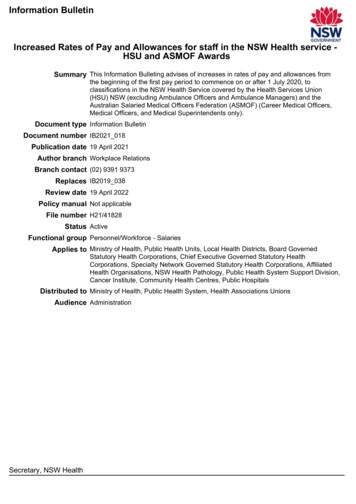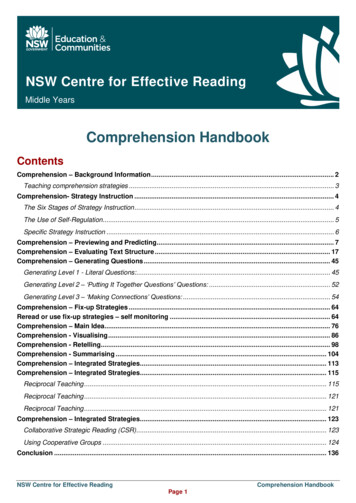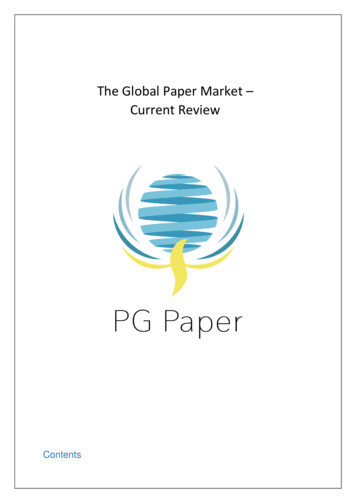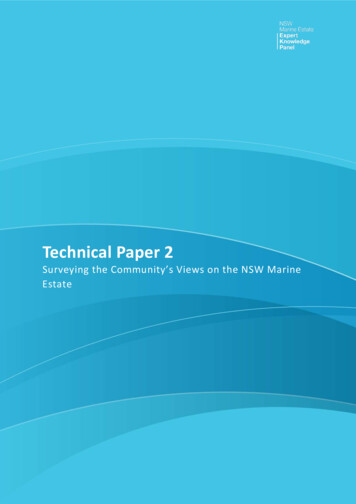
Transcription
Technical Paper 2Surveying the Community’s Views on the NSW MarineEstate
Marine Estate Expert Knowledge PanelCommunity Survey Technical PaperNSW Government copyright State of New South Wales 2014This publication is copyright. You may download, display, print and reproduce this material provided thewording is reproduced exactly, the source is acknowledged and the copyright, update address and disclaimernotice are retained.The NSW Marine Estate Management Authority (MEMA) is advised by the Marine Estate Expert KnowledgePanel (MEEKP). It was established by the NSW Government in 2013 to advise it about policies, priorities anddirections for the NSW marine estate.The NSW marine estate includes marine waters, estuaries and the coast. It extends seaward out to threenautical miles and from the Queensland border in the north to the Victorian border in the south. The fulldefinition and map can be found at www.marine.nsw.gov.au.Published by the Marine Estate Expert Knowledge Panel, July 2014: Dr Rick Fletcher, A/Chair Dr Kate Brooks Dr Neil Byron Professor Emma Johnston Peter McGinnityDisclaimerThis report has been prepared on behalf of the New South Wales (NSW) Marine Estate Expert KnowledgePanel. The views and opinions contained in this report are not necessarily those of the NSW Government. TheNSW Government takes no responsibility for the accuracy, currency, reliability and correctness of anyinformation included in the report. Some of the information and opinions contained in this report have beenprovided by third parties, for which neither the Panel nor the NSW Government take any responsibility.ContributorsThe Panel acknowledges the key contributions of the following experts and departmental officers: Dr Kate Brooks & Dr Neil Byron, Marine Estate Expert Knowledge Panel Sarah Fairfull, Lesley Diver, Kristen Bronger, Fisheries NSW, NSW Department of Primary Industries Fiona Curley, NSW Office of Environment & HeritageRecommended CitationMarine Estate Expert Knowledge Panel (2014), Technical Paper 2: Surveying the Community’s Views on theNSW Marine Estate. NSW Marine Estate Expert Knowledge Panel, July.National Library of Australia Cataloguing-in-Publication entryTechnical Paper 2 - Surveying the Community’s Views on the NSW Marine EstateISBN 978 1 74256 667 2Available on the internet at www.marine.nsw.gov.auEnquiries regarding this document should be directed to contact.us@marine.nsw.gov.auTRIM reference INT14/75884www.marine.nsw.gov.au1
Marine Estate Expert Knowledge PanelCommunity Survey Technical Paper1. Background1.1 ContextTo implement the underlying principles that have been developed for the management of the NSW marineestate outlined in Managing the Marine Estate: Purpose, Underpinning Principles and Priority Setting (MEMA,2013), a robust threat and risk based approach has been developed. This involves undertaking a logicalsequence of steps, which aim to maximise the benefits that the community as a whole derives from the marineestate. This technical paper outlines the methods the Marine Estate Expert Knowledge Panel considerappropriate for the partial completion of step 1. The full set of steps and activities that will need to beundertaken to implement this approach for managing the marine estate is at Appendix 1.1.2 The need for social science to inform managementThe Report of the Independent Scientific Audit of Marine Parks in NSW found that there was generally a poorapproach to social assessment for marine estate planning, if undertaken at all (Beeton et al. 2012, p.57). Itrecommended a more strategic and rigorous approach to social benefit and cost assessment that looks beyondthe simple ‘support versus opposition‘ approach of public participation. Such an approach would allow for adeeper understanding of the importance of access and use of the marine environment for all user groups andprovide more meaningful discussion around potential trade-offs to achieve optimal environmental protectionand community support for marine parks where a benefit is identified. It also noted that given the dynamicnature of our social environment, the process must include ongoing assessment of the social impacts andbenefits of these assessments and these should be reported as part of the overall reporting of marine estateeffectiveness and impacts.The Audit also noted that there was a view expressed in workshops with some stakeholder groups thatprevious community engagement in marine park planning in NSW had been inadequate and often undertakenwith predetermined outcomes in mind. Some submissions to the Audit claimed that stakeholders had largelybeen alienated from the Marine Parks Authority planning processes. This alienation had been due to problemswith the processes: ‘over-consulting’ without clear outcomes; public participation processes being used as aproxy for social research; lack of quality input from the science to enable educated and informed engagement;and a lack of transparency around why and how decisions have been made by not closing the feedback loop.The Audit requested that NSW marine estate planning processes ‘be improved immediately to allow for a morestrategic and cross-disciplinary approach to considering social impacts’ (Voyer et al. 2012, p. 437), which shouldinclude ‘specific and targeted consideration of social impacts (incorporating qualitative research techniques),with particular attention given to vulnerable groups within the community’ (Voyer et al. 2012, p. 437), and‘incorporation of social science expertise into planning [and management] processes [to] ensure social dataare gathered and analysed in a meaningful and scientifically robust manner’ (Voyer et al. 2012, p. 437).In relation to vulnerable groups, the Audit noted that the Indigenous people of NSW have a continuingcustodial relationship with ‘Country’, the land, sea and resources. This extends to maintaining spiritual links to,and caring for, Country. It also noted that Indigenous communities stated that their values and concerns haverarely been appropriately factored into marine estate management in general, and not into marine parkdesign and management in particular.1.3 The NSW Government’s responseIn response to the Audit findings the NSW Government announced a program of reforms which aim to deliveran integrated and coordinated approach to management of the marine estate. The reforms note that decisionswill based on research across environmental, economic and social science (NSW Government, 2013).www.marine.nsw.gov.au2
Marine Estate Expert Knowledge PanelCommunity Survey Technical PaperImproved processes for community engagement are outlined in the NSW Government’s response including: support for increased Aboriginal engagement and participation in management and the need to takeinto account culture and traditional knowledge, support for improved community engagement and education strategies in marine estate and marinepark planning and management, developing planning tools to improve consideration of economic and social information in planningand decision making, revitalising local marine park advisory committees to give local communities a better say in decisionmaking, and, replacing the former Marine Parks Advisory Council with a focus on targeted stakeholder and expertconsultation and engagement on strategic matters.2. IntroductionAs part of the NSW Government’s response, the Marine Estate Management Authority (the Authority) outlinedits new approach to marine estate management via the release of Managing the NSW Marine Estate: Purpose,Principles and Priority Setting (MEMA, 2013). The paper outlines the principles and processes that will be1followed in providing advice to the NSW Government on the NSW marine estate .Principle 1 of the paper outlines the process for ‘effective community engagement to identify and prioritisebenefits and threats’. It notes the need for a thorough understanding of the key community benefits derivedfrom the NSW marine estate at the local, regional and state level, as well as threats to those benefits.Information on these benefits and threats can then be achieved through ongoing and effective communityengagement and expert input. The principle notes that a critical component of this first step will be to fullyunderstand the community benefits that the marine estate provides, environmentally, economically andsocially, with specific reference also to Indigenous communities. An essential element of this was also toattempt to identify the best engagement strategies.To inform Principle 1, the Marine Estate Expert Knowledge Panel (the Panel) recommended that the Authoritycommission a range of qualitative and quantitative social science research (collectively termed the ‘MarineEstate Community Survey’) to identify and analyse the views of the NSW community about the benefits,threats and opportunities presented by the marine estate. The Panel identified the need for this critical firststep to allow the Authority to better understand the range of views amongst NSW communities on the valuesand benefits provided by the marine estate, the threats to those values and benefits, and opportunities toimprove its management both now and in the future. No such research had been conducted to date at a statewide scale in NSW to inform decision-making on marine estate management. This technical paper describeshow this survey was undertaken, lessons learnt and how these results should feed into marine estatemanagement over time.1The NSW marine estate includes marine waters, estuaries and the coast. It extends seaward out to three nautical milesand from the Queensland border in the north to the Victorian border in the south. The full definition and map of the marineestate can be found at www.marine.nsw.gov.auwww.marine.nsw.gov.au3
Marine Estate Expert Knowledge PanelCommunity Survey Technical PaperThe survey is one component of effective early engagement to inform Principle 1 and the other steps outlinedin Appendix 1. It also attempts to deliver on the following principles of community and stakeholderengagement outlined in the Authority’s Community and Stakeholder Engagement Strategy (MEMA, 2014):ParticipationThe community and stakeholders will have the opportunity to be engaged indecisions about the marine estate that will affect their livesEarly involvementThe community and stakeholders will be involved early in the decision-makingprocess3. Survey DesignThe Panel aimed to ensure that the design of the Marine Estate Community Survey (the survey) was able tocapture the range of views amongst the NSW public who value the marine estate from social, economic and/orenvironmental points of view, including those who may be direct or indirect users of the estate as a resource.The Panel noted the importance of ensuring that the design of this (and any future) survey: is representative of the views of the broader NSW community spatially (i.e. not only along the coastbut also including the views of inland residents); across key marine estate interest/user groups; andsocially (i.e. includes Indigenous and culturally and linguistically diverse community representatives); includes qualitative research methods to inform the quantitative research; uses randomised sampling methods to avoid biased results; includes a variety of media and methods to reach a representative cross-section of NSW communitymembers; includes marine estate interest/user group mapping to identify the direct and indirect relationshipsbetween these groups; allows findings to be reported at both the estate-wide and regional scale (note for the purposes of thefirst survey that Local Land Services regional boundaries were used to allow the results to informthese key regional natural resource management authorities); captures community members’ contact details, where agreed, for use in future engagement activities; implements an evaluation framework; incorporates scientific rigour into the qualitative and quantitative survey components; and incorporates privacy standards for data management and reporting that meet legislativerequirements.A Request for Quote for the survey project was developed and approved by the Panel. Nine social researchbodies were invited to tender for the project and these tenders went through a rigorous evaluation process toensure: their project team had demonstrated experience in undertaking similar projects with the community; their project team had human resource capacity including qualifications, skills, experience andinvolvement of their key personnel; had limited reliance on sub-contractors to complete the research; had the ability to deliver the project within agreed timeframes; the proposed research methodology incorporated the design elements outlined above;www.marine.nsw.gov.au4
Marine Estate Expert Knowledge PanelCommunity Survey Technical Paper control systems were in place (e.g. quality assurance, ethical standards), including professionalmembership and accreditation; the methodologies proposed showed innovation or value adding components; and good value for money.An Australian market research company was selected and tasked with designing and implementing the surveyto achieve the aim and objectives outlined below.3.1 AimTo conduct a representative community survey of the NSW community to understand the environmental,social and economic values of, and benefits derived from, the marine estate.3.2 ObjectivesPerceptions of the marine estate Define what marine estate interest/user groups and the communityview the marine estate to be Ascertain how marine estate interest/user groups and the NSWcommunity want the marine estate to look like in 20 years (and howthey envisage marine estate management strategies should evolveto meet this ideal)Values of the marine estate Identify the perceived short and long term economic, social andenvironmental values of the marine estate Determine the benefits they derive from the marine estate Record perceived changes in the Marine Estate over the short termand the long term and establish perceptions as to why these haveoccurredThreats to the marine estate Determine the perceived threats (both current and future) to themarine estate Prioritise these threats and identify areas that the public and themarine estate interest/user groups consider to need the mosturgent attentionOpportunities for the marineestate Identify potential directions for vision development for the marineestate as suggested by key marine estate interest/user groups Understand the perceived opportunities for the marine estateamong the public and marine estate interest/user groups Prioritise values, benefits and vision according to key marine estateinterest/user groups and the NSW communitywww.marine.nsw.gov.au5
Community Survey Technical PaperMarine Estate Expert Knowledge Panel3.3 MethodsThe following methods were deployed to implement the survey:StageTarget AudienceInceptionThe Authority,Panel members& staffWorkshop to finalise the scope and methods for the survey. Aims and objectivesof the survey clarified.NSWresidents*Media release and website information provided via www.marine.nsw.gov.au toadvise the community that the survey had commenced (13 Jan 2014).Marine ityrepresentativesDetailed in-depth interviews (45 minute duration) with 36 key marine estateinterest/user groups. Five of these interviews were conducted with Indigenouscommunity representatives (two from the South Coast, two from the NorthCoast and one from the NSW Aboriginal Land Council).Cross-sectionof the NSWcommunitySeven regional focus groups conducted with 8-12 members randomly recruitedto represent a cross-section of the local community (1.5-2 hours). Focus groupswere held in Lismore, Coffs Harbour, Newcastle, Sydney, Batemans Bay, Edenand Orange. Focus groups in Coffs Harbour and Batemans Bay were asked toconsider values, benefits, threats and opportunities in the context of the marineestate and their local marine park.NSWresidents*A summary of the qualitative research findings from the in-depth interviews andfocus groups was placed on the www.marine.nsw.gov.au website and an onlinesurvey provided to allow the general public to add any new ideas/views to thefindings. A media release was also released to advise of the launch of the onlinesurvey. A separate report was prepared summarising these findings.NSW residentsA 19 minute quantitative online questionnaire was developed based on thequalitative findings from the in-depth interviews and focus group discussions. Apanel provider was used to randomly source a minimum of 1,000 respondentsrepresenting an unbiased cross-section of the NSW community (based on age( 18 years of age), gender, income and regional location).NSW coastalresidents &visitorsA 10 minute quantitative tablet-based field questionnaire was developed basedon the qualitative findings from the in-depth interviews and focus groupdiscussions. The questions were sourced from the online questionnaire. Coastalresidents and coastal visitors (minimum of 350 each) to the marine estate wererandomly sampled (weekdays and weekends) and interviewed using the tabletquestionnaire. To meet these totals a minimum of 50 residents and 50 visitorswere sampled at each of the following 7 locations: Ballina, Coffs Harbour,Newcastle, Pittwater, Circular Quay, Batemans Bay and Eden.NSW residentsFinal reports summarising the findings of the qualitative and quantitativeresearch and community consultation are available at the Marine EstateCommunity Survey webpage. The reports include a list of marine estateinterest/user groups interviewed, the discussion guides and questionnaires usedduring the rtingMethodsNote: * This relates to elements of the survey project conducted by the Authority. All other elements of the survey research wereconducted by the Australian market research company.www.marine.nsw.gov.au6
Marine Estate Expert Knowledge PanelCommunity Survey Technical PaperThe qualitative research methods ensured that the range of views of marine estate interest/user groups werecaptured via in-depth interview and compared and contrasted with the views of the broader NSW communityderived from the regional focus group discussions. Regional variations in responses could also be determinedfrom this approach.The two methods used for the quantitative research (i.e. an online survey and tablet-based field interceptsurveys) allowed the results for the NSW general community sampled online to be compared with the findingsfrom the field intercept surveys of coastal residents and visitors at locations adjoining the marine estate. Themethods could determine areas of consensus and variation between the three respondent groups (i.e. NSWgeneral community, coastal residents and coastal visitors) and at estate-wide and regional scales.In recognition of the uniqueness of the Indigenous community’s views, a specialist consultant with expertise inIndigenous community engagement was commissioned, and conducted four of the five in-depth interviewswith regional Indigenous representatives. The results were incorporated into the Qualitative Research FinalReport and these specific findings are included in an Appendix to this report at the Marine Estate CommunitySurvey webpage.Overall, it is recognised that many other social research methods are available. However, the Panel found thatthe above mix of qualitative and quantitative methods allowed for the triangulation and cross-checking ofresults, provided a scientifically robust survey design and was cost-effective in achieving the aims andobjectives of the survey.4. ResultsThe results of the survey, including estate-wide and regional analysis, can be viewed at the Marine EstateCommunity Survey webpage.5. Conclusions5.1 Lessons learnt from the surveySome key lessons have been learnt during the implementation of the survey whi
Marine Estate Expert Knowledge Panel Community Survey Technical Paper www.marine.nsw.gov.au 4 The survey is one component of effective early engagement to inform Principle 1 and the other steps outlined in Appendix 1. It also attempts to deliver on the following principles of communi

